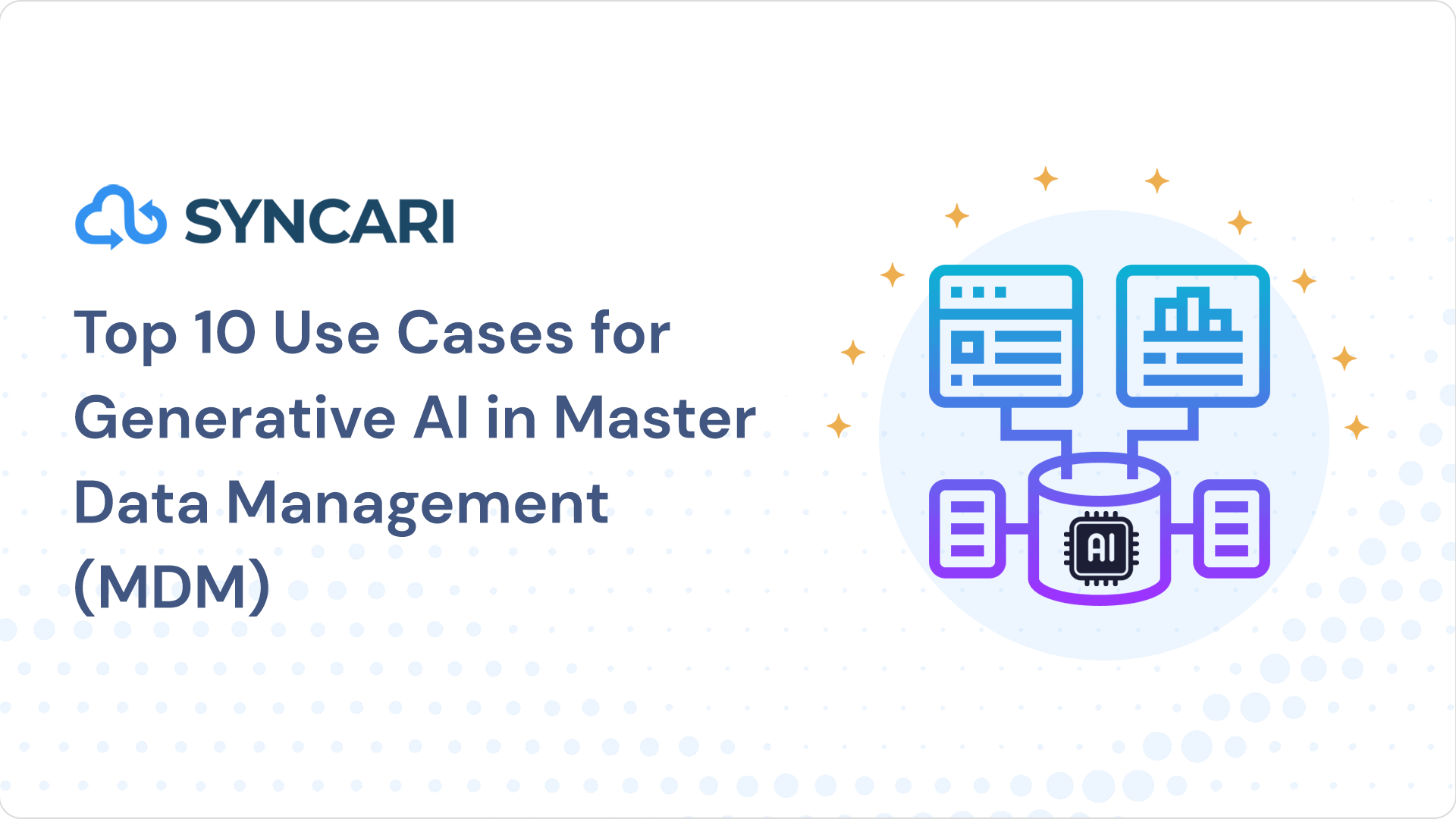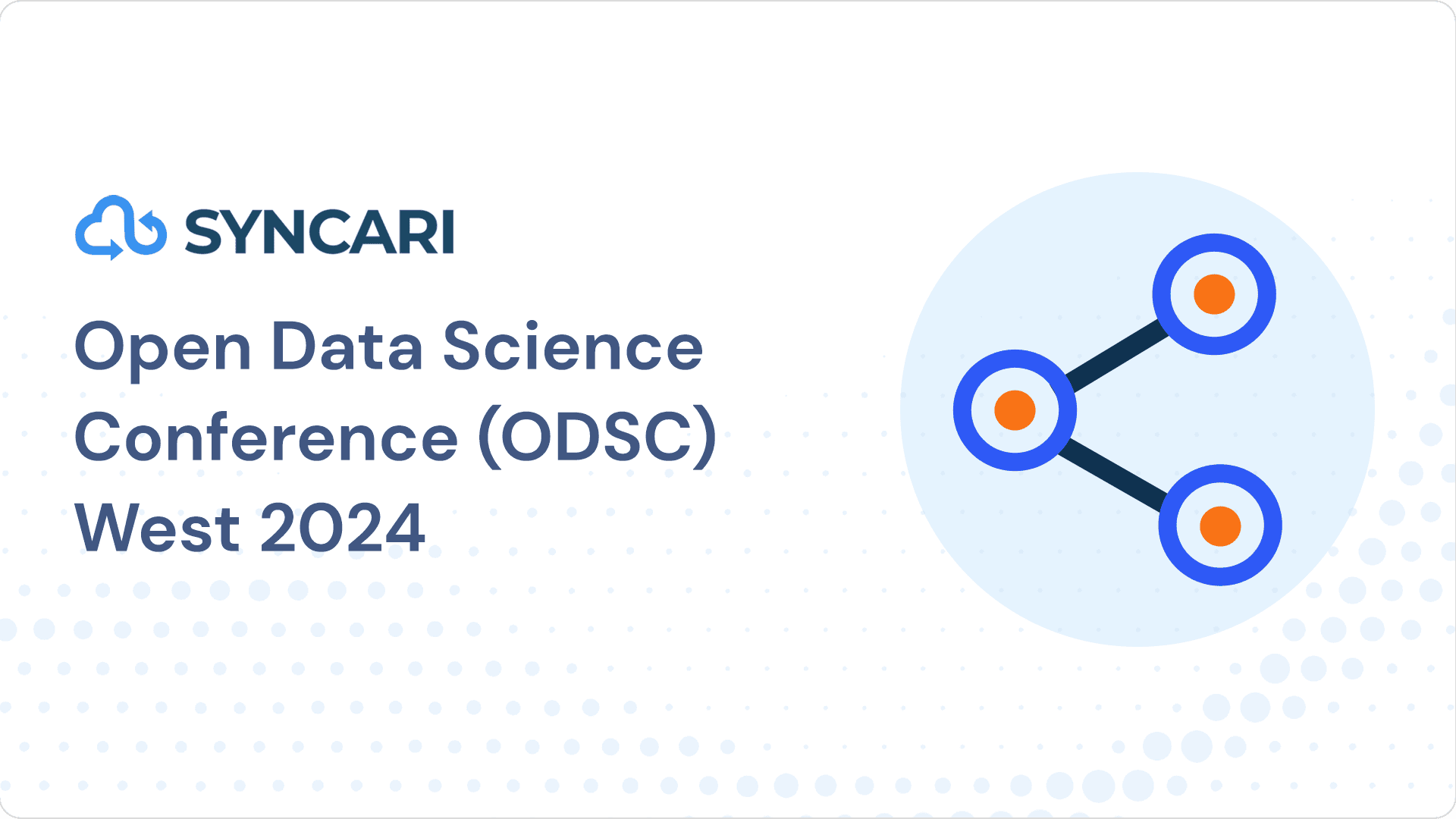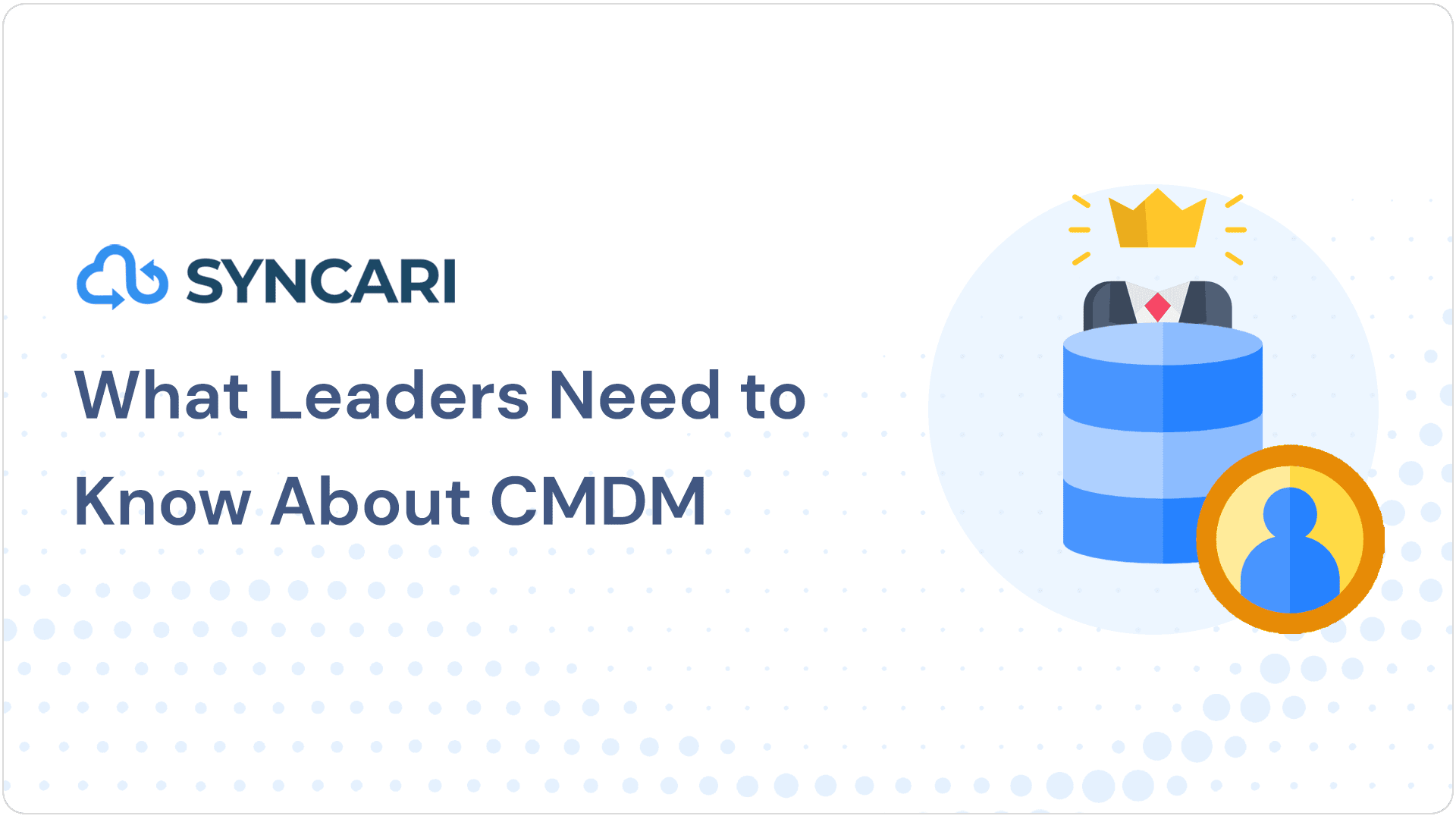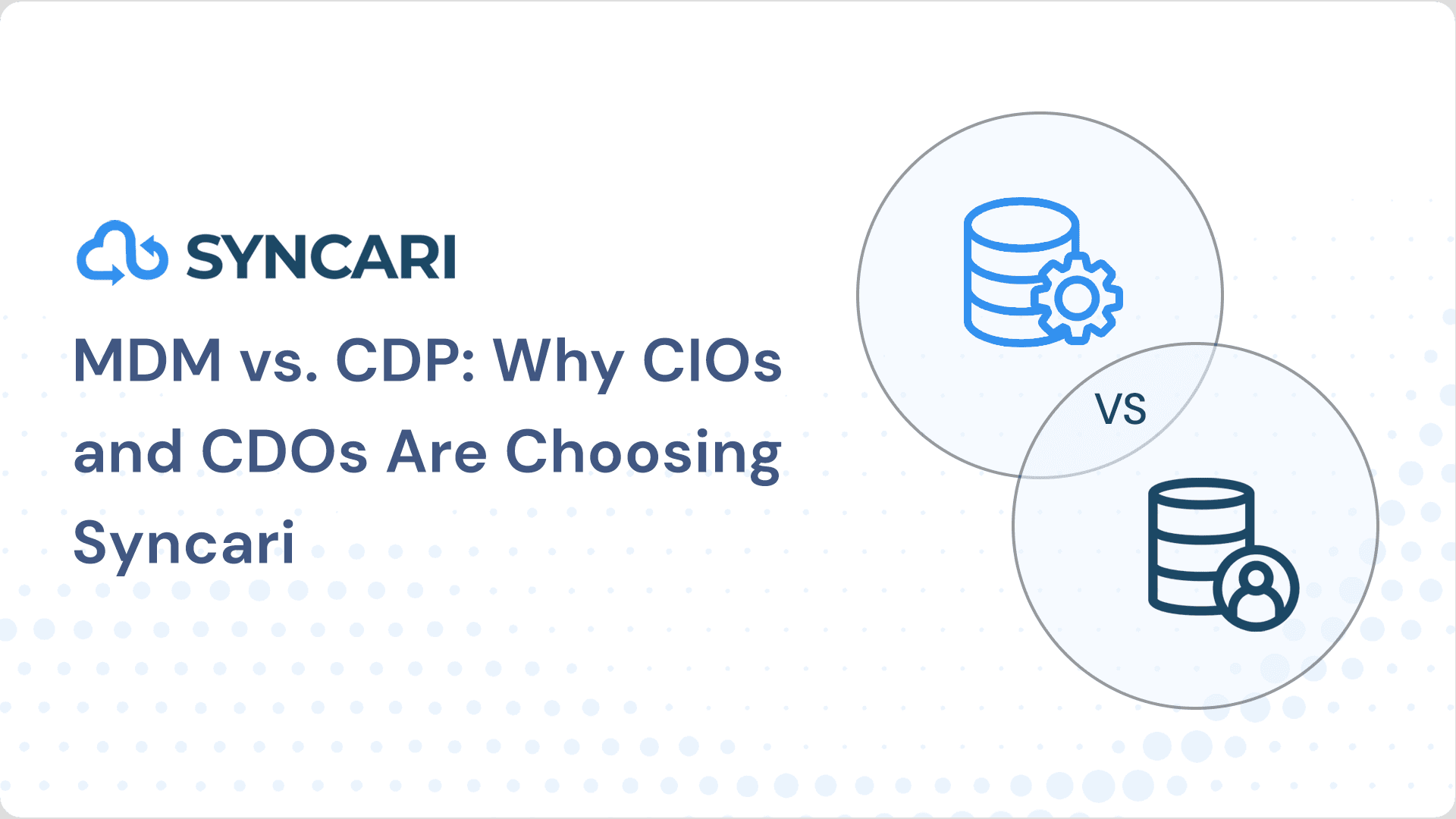How to Classify and Manage Data for Business Success
- Misclassifying non-master data as master data leads to inefficiencies, higher costs, and increased risks.
- Master data includes core, stable information that supports multiple systems and processes across an organization.
- Classification ensures data quality, reduces duplication, and aligns with business goals, such as operational efficiency, compliance, and revenue growth.
- Syncari’s Autonomous Data Management platform helps businesses accurately manage master data through automated workflows, real-time synchronization, and AI-driven data quality checks, driving better business outcomes and minimizing risks.
Misclassifying non-master data as master data is a common issue that leads to increased costs, inefficiencies, and heightened risks. Both business and technical leaders must correctly identify master data to support use cases and achieve meaningful business outcomes.
Quick Answer: How to Identify Master Data?
Master data refers to core, business-critical information that supports multiple systems and processes across an organization. Correctly classifying and managing this data ensures accurate insights, reduced costs, and minimized operational risks. In this blog, we’ll guide you through how to evaluate and classify master data to optimize your data management strategy.
Trusted master data is the foundation of any data-driven organization. By properly identifying it, businesses are better positioned to make informed decisions that directly impact risk management, revenue growth, and operational efficiency.
Why Master Data Classification Matters
When correctly classified and managed, master data improves data quality, consistency across departments, and operational efficiency. It allows organizations to gain real-time insights, reduce duplication of effort, and ensure compliance with regulatory requirements.
However, when non-master data is mistakenly classified as master data, it can cause scope creep, inflate costs, and waste resources. Let’s explore how to effectively classify master data and avoid these pitfalls.
Master data refers to the critical, foundational entities that are consistently used across various systems and business functions within an organization. These core entities include customer information, product details, and supplier identifiers —data that remains stable and is essential for driving key business processes like sales, marketing, finance, and supply chain management.
Unlike transactional data, which records specific events like sales, orders, or social interactions, master data provides a consistent and uniform set of identifiers and extended attributes that describe an enterprise’s core elements. These elements often include customers, citizens, patients, suppliers, students, physical locations, products, parts, and assets.
Examples:
- Master Data: Customer name, date of birth, primary address, product SKUs, supplier codes.
- Non-Master Data: Transaction details, product prices, social media interactions, sales records.
Master data offers businesses a unified, trusted enterprise-wide view of their most critical information, positioning them to make informed decisions that directly impact risk, revenue, operational efficiency, and cost management. Well-governed master data can support a wide range of business objectives, such as:
- Supply chain optimization
- Enhanced patient care or improved customer experiences
- Opportunities for cross-sell and upsell
- Regulatory compliance
Business goals that rely on a consistent, accurate view of core entities across the enterprise will greatly benefit from a modern master data management (MDM) program. Organizations with robust MDM are better prepared to leverage AI, as they have trusted, AI-ready data that supports advanced analytics and automation initiatives.
Successful MDM initiatives begin by identifying and prioritizing the business outcomes that master data will support. By aligning master data management with strategic business goals, organizations ensure their data efforts drive meaningful value and provide a foundation for scalable, data-driven growth.
Evaluating Master Data Attributes
To properly manage master data, leaders need to identify which data qualifies as master data. Key attributes to evaluate include:
- Consistency and Uniformity: Does the data need to remain consistent across all departments and systems? For example, a customer’s date of birth should follow the same format (e.g., DD/MM/YYYY) throughout the organization.
- Identifier Usage: Is the data used as a unique identifier? For instance, customer IDs, product SKUs, and global trade item numbers (GTINs) are essential for identifying unique entities.
- Data Stability: Does the data remain stable over time? Master data, such as customer names or product dimensions, tends to be stable, while transactional data, like sales records, changes frequently.
- Cross-Functional Relevance: Is the data used by multiple departments and applications? For example, customer data is relevant to marketing, finance, customer service, and supply chain teams, making it a strong candidate for master data.
- Business Impact: Does the data play a critical role in achieving business goals like operational efficiency, compliance, or cost reduction? Data that impacts key outcomes should be considered master data.
Avoiding Misclassification of Non-Master Data
Misclassifying non-master data, such as transactional or pricing information, as master data can dilute governance efforts and lead to inefficient data management.
Examples of Misclassified Data:
- Master Data: Customer IDs, product SKUs, supplier codes.
- Non-Master Data: Temporary pricing information, order details, and social media interactions.
Focusing on data that has long-term business value will help ensure that resources are efficiently allocated to managing the most critical information.
Why Master Data Should Be Tightly Scoped
Master data should include core, stable attributes that describe key entities. Expanding the scope to include attributes that are not relevant to the broader business or that change frequently introduces unnecessary complexity and costs to governance efforts.
Before classifying data as master data, ask: “Does managing this data reduce costs, improve efficiency, or mitigate risks?” If not, it may not qualify as master data.
Align Master Data with Business Outcomes
The primary goal of master data management (MDM) is to improve business outcomes. Data and analytics leaders should focus on master data that directly supports organizational goals, such as enhancing customer experiences, streamlining supply chains, or ensuring compliance.
When evaluating master data, consider:
- Does it reduce costs or streamline operations?
- Is it critical for compliance or risk management?
- Does it support key performance indicators (KPIs)?
By aligning master data with business goals, organizations can ensure their MDM efforts deliver measurable value.
How Syncari Simplifies Master Data Management
Syncari’s Autonomous Data Management (ADM) platform unifies, cleans, and orchestrates master data across multiple systems and domains. By leveraging Syncari, businesses can eliminate scope creep and focus on the data that truly matters for real-time business decisions.
Key Features:
- Integrated Data Fabric Architecture: Seamlessly unifies data from various sources, reducing complexity and enabling a unified view that drives accurate insights and streamlines operations.
- Multi-Directional Sync: Ensures real-time, bi-directional synchronization of data across all systems, maintaining data consistency and enabling agile decision-making.
- Programmable MDM via Extensibility: Offers customization options for MDM workflows, allowing businesses to tailor their data management processes to meet specific needs.
- Enhanced Automation with AI and ML: Automates the MDM process, reducing manual intervention, minimizing errors, and enabling predictive analytics and intelligent data matching.
Benefits for Your Organization:
- Speed to Value: Rapid implementation ensures quick time-to-value.
- Reduced Total Cost of Ownership (TCO): Predictable pricing based on the number of records managed, resulting in lower operational costs.
- Democratized Access: Business users can manage data without relying on IT, freeing up technical resources for high-value tasks.
Properly evaluating and classifying master data is essential for ensuring your MDM strategy drives business success. By focusing on data that has cross-functional importance and aligning it with key business goals, organizations can reduce costs, improve decision-making, and enhance operational efficiency.
Syncari’s Autonomous Data Management platform provides a comprehensive solution for governing master data, enabling businesses to maximize the potential of their data strategy.
FAQs
- What is the difference between master data and transactional data?
Master data includes core, stable information such as customer and product identifiers, while transactional data reflects specific business events, like sales or orders.
- Why is it important to classify data correctly?
Correct classification ensures that only critical data is governed, reducing operational costs, improving efficiency, and minimizing risk.
- How does Syncari help with master data management?
Syncari’s modern master data platform, Autonomous Data Management automates the unification, governance, and synchronization of data, ensuring data accuracy and democratized access and alignment with business goals for real-time decisions.
Learn more about how to unlock the power of Autonomous Data Management.



